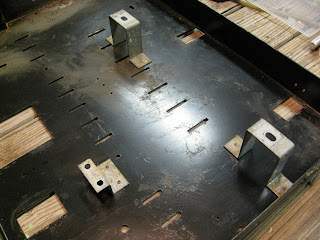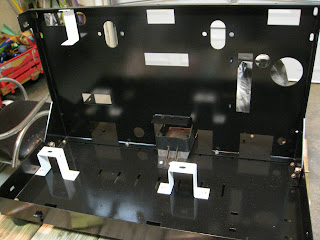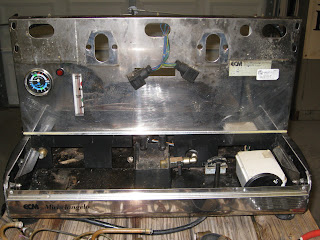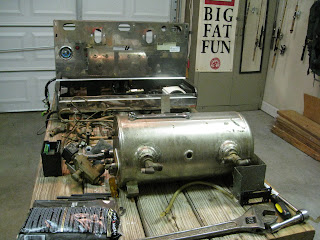The answer, Citric Acid. I think the suggested solution was 2-4 tablespoons of citric acid to one gallon of water. I started surfing Amazon and Ebay for sources after striking out in the local health food stores, and couldn't seem to find anything larger than small containers of 8-12 ounces which cost around $8, and then $4-5 shipping. Then I struck gold on Ebay. $25 for 5 pounds of citric acid. Yeah, it was a little overkill, but that $25 included shipping, and who knew what else I might want to descale in the future. Maybe steam punk would emerge into the mainstream, and I would be the man to polish Jules Verne's time machine. Either way, I may have ended up on a government watch list, or at least a bath-bomb sewing circle for ordering that much in bulk.
I used the top of a large Rubbermaid storage bin and warmed up a gallon pot of water on the stove as heat speeds up the reaction of the acid solution with the metal. I didn't heat all the water, but just enough to raise the temp to around 120 degrees in the container which was already half full with a gallon of cold water. I dissolved about 4-8 tablespoons of citric acid (looks like table salt) into the water and then added the tubing. The reaction was almost instantaneous. The copper started brightening up and losing its dull brown, turning almost pink. The brass started shining through the grime as it fell away. It was pretty amazing. I let it soak for a good 20-30 minutes, occasionally arranging the odd shaped tubing so that it would all get exposed. The soak also broke up most of the mineral deposits inside the tubes. I took all the tubing out rinsing it the best I could, and set it out to dry on a towel on my workbench. I picked up a couple of small pieces and tried some very fine steel wool on it. The shine it brought out was brilliant!
Over the course of the next couple of months when I had a half hour or more to spare, I would sneak down to the garage and shine up the tubing with steel wool. I cleaned it meticulously to the point of shining all 6 sides of each brass nut as well as the top and bottom. There are shiny parts on this machine that will probably never see the light of day again, but I know they're in there.

After finishing up with the brass and copper parts, I decided to clean up the stainless steel back plate and the two stainless steel shims the drip tray is supported from. Again, from the wisdom of the forums, I learned that citric acid is bad for ferrous metals and that the micro-abrasive qualities in car polish would work wonders... unless I wanted to spend the money to have the plates shined professionally by a fabrication shop. (I didn't). While not all the scratches came out, I was able to get the haze removed from the stainless and it looked good enough for my tastes.
I gave the boiler the same citric acid soak treatment as the tubing and used a brass brush to scrub it the best I could. I wanted to really sand it smooth and give it a near mirror finish, but the welds around the connections and seams would not have supported that level of detail and to grind them smooth might reduce the integrity of the boiler. Who wants to have 17 liters of scalding hot water and steam under 15 bars (atmospheres) of pressure explode due to manic cosmetic attention to detail? Not me. I got it clean and confirmed there wasn't any scale inside the boiler which was surprisingly clean. I thought that 5 years of having water sloshing around inside would have been more damaging, but it held up wonderfully.

Now I had a bigger fish to fry before I could start reconstructing. THE GROUP HEADS OF DEATH! I had to get these cleaned up and the fossilized gaskets out before putting much of anything else back onto the frame. But I'll save that for the next post.







